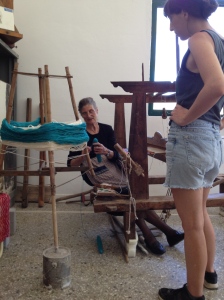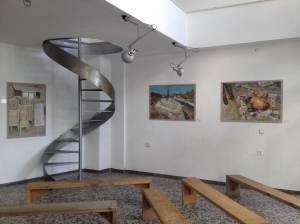“Weaving” the textile heritage of Gonies in Crete
Written by Katerina Konstantinou
The “loom-project” was centered on women’s weaving practices and drew upon art and ethnographic methods. The first seeds of this project were planted in the summer of 2015 at the 2nd Archaeological Ethnography Summer School organized by the Heritage Management Organization in Gonies, Crete, which I was attending as a postgraduate student. My contribution to the school’s fieldwork, conducted within the broader context of the Three Peak Sanctuaries of Central Crete research program, focused on unraveling the history of weaving in Gonies. A year later, Alexia Karavela, an Athens-based visual artist, joined me to further investigate the multitude of stories, reminiscences and songs related to woven textiles and their production. This was made possible due to HMO’s decision to host an artist-in-residence program alongside the 3rd Archaeological Ethnography Summer School.
My preliminary fieldwork on weaving raised many issues regarding the textile heritage and its multiple uses in the past, present, and future. Whereas non-mechanized cloth production was largely abandoned in Greece after WWII due to the industrial production of textiles, looms remained in use in Crete to meet growing demand for souvenirs in the early 1970’s. During this period, textiles were mass-produced throughout the island and were sold by wholesalers all around Greece. It was within this context that weaving provided a significant source of income in Gonies from the late 1970’s until 2000.
 Material evidence of this relatively recent past abounds in Gonies. Nearly every house has its own loom. Many textiles, collected and preserved mainly by elderly women, have survived long past their period of use. These collections provide a rich source of information concerning the relation between memory and the material world. For instance, the textiles recall memories of the past in which almost every woman was weaving day and night.
Material evidence of this relatively recent past abounds in Gonies. Nearly every house has its own loom. Many textiles, collected and preserved mainly by elderly women, have survived long past their period of use. These collections provide a rich source of information concerning the relation between memory and the material world. For instance, the textiles recall memories of the past in which almost every woman was weaving day and night.
The idea of continuing the research next year was born out of this relation between material and memory. In order to deal with the material nature of textile production and bridge the gap between research and practice, I invited Alexia Karavela to join me. Alexia has been concerned with ethnographic themes and issues of materiality, social memory and identities in her work as a visual artist (http://alekakaravela.blogspot.gr/). With a particular focus on the recent political history of Greece, she critically comments on the everyday life that continued alongside great political events of the 1980’s and 1990’s. In one of her previous works, presented for her Master of Fine Arts graduation in 2015, entitled “I Hira” (“The Hand”), she explored aspects of social memory in the manual production of textiles. Installed alongside other materials, Alexia used an old, very simple loom and textiles woven with unconventional materials such as magnetic tapes to refer to history-writing processes.
Her weaving experience as well as her critical thinking towards cultural heritage and material culture additionally inspired me to design a community engagement art project that combined contemporary art practices and fieldwork methods for the summer of 2016. Alexia was to apply her artistic practices on the fieldwork, and I was to coordinate the project and collect the ethnographic information. We were accommodated by the team of anthropologists and archaeologists, Aris Anagnostopoulos, Lena Stefanou and Celine Murphy, who were running the 3rd Summer School of Archaeological Ethnography in July of 2016.
Shortly after our arrival to Gonies, we transformed a hall of the abandoned school into an open studio, and a local man donated an old loom to Alexia. The loom was restored with the help of some locals and put to working condition. Having thus occupied the school and set up the loom, we set about encouraging locals to help weave a collective textile.

The community of Gonies enthusiastically responded to our call and the school was infused with new life as locals gathered daily to weave or to simply spend time with us. As one local would pick up where another had left off, all who participated left their mark on what became a collective, community rug. Locals of all ages had an eagerness to weave that had many different motivations: such as a desire to experience the past, to understand this old tradition, or even to reignite potentially profitable local industry. In all cases the experience of weaving in a loom was perceived as performing part of cultural heritage. On our part, weaving served as a point of departure by which to communicate with people and observe them interact with locally-significant objects. These interactions provided a rich source of ethnographic data not only regarding what people remember but also how they remember and how they forget.

Later on during this one month stay in Gonies, a second loom was brought to our studio in the school by local women. This loom was dismantled, moved in and restored again to weave a triopatitero, a weaving technique that is considered to be characteristic of the island of Crete and requires particular skills and knowledge. The energy with which elderly women commandeered the project made us step aside at times and watch them act. After all the “loom-project” aimed at making the local community define what was there to be preserved as part of their textile heritage.
Moving beyond the traditional fieldwork methods required that we collaborate with the locals and therefore made us reconsider the ways we do ethnography. Rather than imposing out own research framework, we hosted them in an open studio that was designed to inspire some artistic production through which Goniotes were actively involved in defining the textile heritage of their village by nominating heritage items and by ensuring local knowledge. We allowed locals to decide on the project, to a great extent, and thus avoided playing an over-determining role in the interaction. We found that artist Alexia Karavela’s presence considerably facilitated local involvement in interpreting their heritage. Her artistic approach to the field of ethnographic research elucidated issues relevant to the poetics of fieldwork. Such an approach strengthens the creative and metaphorical dimension of the discourse produced through ethnography and challenges the ethnographer’s conception of the ways we conduct fieldwork.
The “loom-project” incorporated a series of paintings produced by Alexia as a way to analyze and interpret the ethnographic material gathered in Gonies. An exhibition was put together almost a year later in DA, an artist-run space in Heraklio, which is the closest city to Gonies, where most Goniotes live during the winter. Through this exhibition, Alexia proved that artists can use their position to bring new dynamics and practices not only to the production of ethnographic data but also to its interpretation and representation.
Although ostensibly investigating the position of textile heritage in Gonies as cultural and economic resources, the “loom-project” was largely focused on an exploration of new ethnographic methods. Equally significant was the investigation of new ways of representing ethnographic knowledge. Several issues regarding the relationship of art and anthropology were raised during all phases of the “loom-project” such as the appropriation of methodologies and subjects between them that demand further consideration by the actors of the project.
 Katerina Konstantinou is a PhD candidate in the Department of Social Anthropology at Panteion University. She is an art historian and holds an MA in Curating. Her research interests focus on the intersection of the fields of contemporary arts, anthropology and archaeology. She has participated in several research programs, such as the Three Peak Sanctuaries in Central Crete in Gonies. She has worked for museums and cultural institutions. She has participated in conferences and she has published texts in collective volumes and art magazines.
Katerina Konstantinou is a PhD candidate in the Department of Social Anthropology at Panteion University. She is an art historian and holds an MA in Curating. Her research interests focus on the intersection of the fields of contemporary arts, anthropology and archaeology. She has participated in several research programs, such as the Three Peak Sanctuaries in Central Crete in Gonies. She has worked for museums and cultural institutions. She has participated in conferences and she has published texts in collective volumes and art magazines.

Georgia Xekalaki
Dec 08, 2017 at 04:11 pmThis is so interesting! Really educates the public on how looms work and how the working space was formed as well!